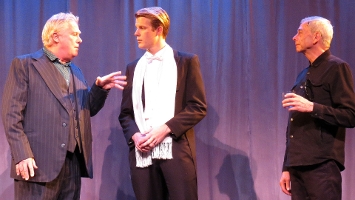The Picture of Dorian Gray
Oscar Wilde’s novel, an examination of youth, beauty and narcissism, has arguably found even greater relevance today. In the age of cinema – and indeed Facebook, instagram and Tindr – the potential for modern adaptation is clear.
The Genesian Theatre Company has commissioned a new play by actor and playwright Nathan Farrow rather than use another adaptation of the masterpiece. Indeed, the full title here is The Picture of Dorian Gray Reimagined. Painter Basil Hallward is now a film director who goes by the name Bas (made to sound like “Baz”, a nice joke). Dorian is still an artist’s subject but this time he’s an actor who looks stunning on film.
Bas captures Dorian in a scene rather than in an oil painting. When he sees that scene, the effect is the same: Dorian gives his soul to never age a day – it’s his portrait (on film) that becomes corrupted as he tears apart the world around him.
Farrow’s adaptation closely follows the plot of the novel in the first act. His writing uses many of Wilde’s words but a lot of the dialogue is new, with mixed success. The second act veers further from the book – not a problem in itself but, in the process, the play becomes long. In his program notes, director Stephen Lloyd-Coombs says the work is being constantly revised. It would benefit with some judicious cuts.
Lloyd-Coombs’ direction is fast and proficient but many of the scene changes are clumsy, with the actors awkwardly moving set pieces such as a drinks trolley or curtains. This could easily be smoothed out.
 The filmed sequences of Dorian are very well done, adding the drama they’re designed to provide. The lighting is particularly effective in these moments, with Dorian’s silhouette contrasting with his image on film on a white screen behind him. But other aspects of the design could be improved. For example, it’s not clear why two ladders are used as set pieces. Other more appropriate pieces could provide similar flexibility in staging.
The filmed sequences of Dorian are very well done, adding the drama they’re designed to provide. The lighting is particularly effective in these moments, with Dorian’s silhouette contrasting with his image on film on a white screen behind him. But other aspects of the design could be improved. For example, it’s not clear why two ladders are used as set pieces. Other more appropriate pieces could provide similar flexibility in staging.
The acting is skilled – and improved during the performance. Michael Yore grows into the role of Dorian; Martin Portus is distinguished as Harry, a modern version of Lord Henry Wotton. Richard Mason delivers a fine Bas and the ensemble works well together.
The conceit of having Harry as a television presenter, co-narrating the play as he interviews Bas, works in moments but the narration could also be cut back.
It’s good to see the Genesian Theatre, which celebrated its 70thbirthday in 2014, creating new works and continuing to provide a training ground for young actors. This play could be greatly improved. The passion at this company is clear and with continued work, The Picture of Dorian Gray Reimagined should develop nicely.
Peter Gotting
Subscribe to our E-Newsletter, buy our latest print edition or find a Performing Arts book at Book Nook.

